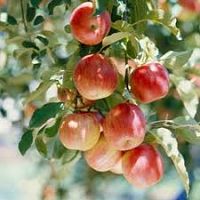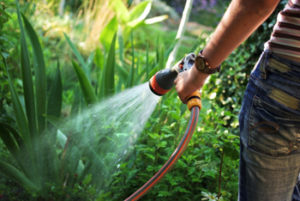by: Janis Norton
of The Urban Farm
Focus from the bottom to the top:
Roots, then Shoots, then Leaves Flowers & Fruits.
The weather is getting hotter earlier, and staying drier longer in my neck of “the woods”. With this we hear about heat-related struggles from too many people, regardless of their experience in growing fruit trees. So I am gathering ideas here to help us all prepare for the coming warm season and mitigate the damage that seems to be coming faster and harder on our trees. You’ve invested time, energy and money into these hopefully long-living, and abundant resources, let’s protect them so they stay that way.
Before this idea of growing fruit trees in the new weather paradigm becomes overwhelming, I would like to share a plan on how to take care of our trees. Below I have broken down what to do in an order that makes the most sense for our trees – roots, shoots, then fruits. This is the order we use to guide our new trees into healthy growth, and in this article I am using it to help guide new tree parents into growing healthier orchards.
— ROOTS — Starting at the bottom
Hydration is key for healthy tree roots, but not so much water that they drown or rot. A simple mistake many people make is overwatering trees because we are worried about the heat. And oftentimes a landscape design puts trees on the same watering system as the smaller bushes and plants, so the watering is too frequent and not deep enough for trees.
Tips
Don’t water daily or even every other day! This can cause root rot as the roots need to dry out a bit between watering. Water is important, but space it out enough to let the soil breathe.
Instead focus on DEEP watering once a week AT THE SOONEST for trees – or even better go twice a month. During the extreme high heat of July-August once every 7 to 10 days is sufficient, assuming you have planted your trees and created a basin full of woody mulch as we teach.
Make sure trees and bushes are on separate watering zones to allow a schedule with different frequency and duration of watering.
Don’t skip the granular fertilization. We recommend feeding with organic fertilizer four times a year in the outer section of the basin under the tree canopy. (The basin should be growing with the tree).
— SHOOTS — moving up the trunk and branches
The trunk and branches are the frame or scaffolding of the tree. Inspect limbs and branches to spot signs of distress such as broken or worn spots, holes, and trunk or bark cracking which can mean different problems and therefore need different solutions. We can improve our trees’ ability to withstand strong or drying winds by improving or protecting the health of the branches and trunk.
Tips
Trim back branches if they are getting too long to support themselves. Consider going back a full third of the branch if needed.
Look for signs of death and cut back until that is gone, trimming to just shy of the next node or leaf. Diebacks will continue if not removed, and on larger branches this dieback can travel into the core damaging whole limbs and trees before the outside shows the damage.
Trim branches that are rubbing together or against walls, fences, or stakes. Weakened bark will allow for disease and pests to gain access to the sweet internal wood. If the wounds are at critical points, take pictures and send them to us for feedback.
Foliar feeding the branches before the new leaves show up will boost the leaf production and encourage growth. We recommend Essence and Soul for this.
Apply biodynamic tree paste or tree paint to protect thin bark from sun or wind burn.
And, if the cause of bark cracking Is still not obvious, take pictures and send them to us. We can help diagnose.
— LEAVES — the part we tend to notice first
The leaves are the most visible parts of our trees, and the first to show signs of stress or sunburn damage. They provide protection for the internal structure from too much sun and are also the most critical part of the tree’s respiratory system.
Trees are actually fairly resistant to most outdoor weather fluctuations if the tree is healthy and the leaves are able to perform their functions. We rely on the leaves to tell us how the tree is doing, so let’s pay attention and give the trees what they need. Shade as too much sun or dry heat can quickly hurt this part of our trees, top level moisture to help keep trees from drying out, and easy to absorb nutrients that will boost immunity.
Tips
Dappled sunlight is preferred for many non-native plants. Shade should adjusted to meet the needs of the plant age and type. Shading young or vulnerable trees is smart and simple if done well.
Grow plants in groups to let the community help shade itself. Use multi levels of plants to help create a cooler environment.
Morning light is best, and afternoon light can be brutal on young or sensitive plants. Choose your plant’s location accordingly or add shade to protect from too much afternoon sunlight
Make note of what good healthy leaves look like, take a picture, then use it to compare it to later if needed.
Foliar feed! Leaves can intake liquid nutrition faster than the roots. A diluted solution can really boost tree health quickly. We recommend Essence and Soul for this.
— FLOWERS — the signs of spring and promise of fruit

Most fruit trees have flowers in the spring, and this is supposed to happen between the freezes of winter and the baking of summer. And if a spring freeze or a surprise heat wave comes when the flowers are in bloom this can disrupt fruit production no matter what you do.
The flowers on our trees are important for fruit production, but they are also for vital for the birds and insects too. Make your entire ecosystem stronger by having a vigorous flowering resource that everyone can enjoy.
Tips
Don’t spray the flowers with chemicals -even organic ones!
Don’t knock off the flowers. We recommend removing young fruit trees of their fruits, but this does not apply to the flowers – keep those.
Foliar feed with nitrogen booster like fish emulsion before the flowers show up as this will improve fruit setting. We recommend Noble Gills and Soul together for this.
Allow the flowers to go through the entire cycle – flowers cycle from a bud, to beautiful bloom when the pollinators visit, then dry up and drop off. Allowing pollinators to visit even if the fruit is going to be thinned is good for the trees and the pollinators as they will remember where to come for yummy food year after year.
— FRUITS — the bounty we wait for each year
 They are the end goal of our orchard, and one of the last parts we need to look at for healthy trees. If you have already chosen fruit trees that produce at the right time of the year then you are more than half way there, if not, check our class Before You Buy Your Fruit Tree. The next challenge with our fruits is helping them get to the harvest safely while dealing with the weather changes.
They are the end goal of our orchard, and one of the last parts we need to look at for healthy trees. If you have already chosen fruit trees that produce at the right time of the year then you are more than half way there, if not, check our class Before You Buy Your Fruit Tree. The next challenge with our fruits is helping them get to the harvest safely while dealing with the weather changes.
Tips
Remove the budding fruit on 1st and 2nd year trees (berries excepted). This can be an emotional challenge for some, so remind yourself this is a temporary process and it will improve the tree’s ability to produce more in the future.
Thin heavy bearing trees like peaches and apples to reduce weight and allow for bigger fruit without damaging the branches.– For peaches, plums and apricots, start at the trunk and work your way to the tip of the branch by keeping only one fruit every 3 inches or so. No fruit at the tips – especially on those young thin branches.. — For apples keep only 3-4 apples in a cluster the first couple production years, then you can keep a couple more after that.
Remove or reduce the fruit if they start to look cooked or unhealthy and you can’t add shade, as this helps to reduce the stress on the tree. A tree that works too hard to keep it’s fruit is actually using up the energy it needs to survive the harsh weather months.
— OVERALL HEALTH — the big picture view
 Trees take moisture from the soil AND the air too. If there is not enough (or too much) in one zone, then the trees rely on the other to help balance its own moisture out. This process is not quick and can use up a lot of energy if the moisture is too far out of balance. Multiple days or weeks of exposure to hot dry wind can pull the moisture out of the tree faster than it can pull it from the roots. At times like this, we can proactively help.
Trees take moisture from the soil AND the air too. If there is not enough (or too much) in one zone, then the trees rely on the other to help balance its own moisture out. This process is not quick and can use up a lot of energy if the moisture is too far out of balance. Multiple days or weeks of exposure to hot dry wind can pull the moisture out of the tree faster than it can pull it from the roots. At times like this, we can proactively help.
Protecting from the damage of the hot, dry (and sometimes non-stop) winds takes a little planning but is worth the effort. There are two major focuses here – both centered around the moisture our trees need to survive.
Moisturize – weekly showers with your hose during the super dry weeks will help prevent desiccation; the larger the leaf, the more frequent the shower. The goal is to just remove the dust that may block the breathing pores, and give the tree a little break from trying to move moisture from the roots to the leaves.
Protect – Check your space for wind tunnels and build wind breaks. Consider the difference between a fan in a warm room versus a hairdryer on low heat pointed at one spot. Anything getting a focused blast of dry warm air will dry out faster – and those trees that get the brunt of the winds traveling between houses dry out faster than the ones in the middle of a yard. If you don’t want a wall or fence next to your tree, a simple horizontal sail with shade cloth on a strong, heat-resistant structure can make a dramatic difference. My preference is using conduit pipe frames settled over rebar stakes in the ground.
In summary, the fruit trees in our yards are a significant investment, and it can be painful to our hearts and our pocketbooks if they fail to thrive. Here at The Urban Farm, we are rooting for your success and sharing these tips to help protect your investment. Check out www.UrbanFarm.org/RootCamp for even more useful information to support you on your tree growing journey. If you already signed up go HERE.
And, finally, if all this doesn’t address your concerns, please feel free to reach out to us at [email protected].










